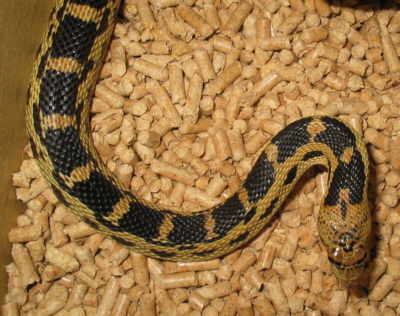|
Besucher:

|
www.pinesnake.de
|
|
|
|
last changes: Sunday, January 06, 2008
|
Great Basin Gopher Snake
Pituophis catenifer deserticola
Desert Gopher Snake,
|
 |
|
|
Distribution
|
|
You can find this snake in the western USA and South Canada. In the north the distribition area begins in the south-western Canada in British Columbia. Connected to this they live in greater parts of the USA from Washington, Idaho and Wyoming to south east California and the northern Arizona. In New Mexico they occure only in the extreme west. Its distribution area borders and intergrades in the west to the subspecies catenifer and annectens and in the south, in the line of northern Arizona, with the Affinis. In the east it don’t reach the subspecies Sayi.
|
|
Description
|
|
This snake can be colored from grey to yellow to sometimes orange (Utha). On the back there are 40-75 body saddles. The color of the saddles begins in the neck with black, lighting up in the middle of the body to a brown tone, then darken towards the tail to black. In the neck the saddle spots can connect each other and sometimes, too, with the side spots. But lately with begin of the second third of the body the saddles become clearly divided. On the side of the body there is a row of black spots alternating to the saddles. Below this there is an other row of small spots wich in Deserticola often is connectet to a stripe on the side of the neck. The belly is white to yellowish with small black spots to the scales on the back. On the head there is a black stripe from the angle of the jaw to the eye, sometimes, too, a stripe between the eyes. Lenght: up to 1.83m, but most of them grow not longer than 1.3m. The scales are keeled. In the midbody there are at minimum 29 scale rows, mostly it are 31-33. Speciality in head scales: 4 prefrontalia. The snout scale (rostrale) is as broad as high (rostrale : nasale 1:1).
|
|
Habitat |
|
This gopher snakes live in several areas like deserts, half deserts, farmland, river valleys, the vinicity of wet lands, open woods up to mountain shapes. It occure between in elevation fom 0m to aprox. 2000m. This snake often inhabits the tunnels of rodents, the same as it use several other hiding places.
|
|
Way of life |
|
The Great Basin gopher snake is mainly day active. In hot summer it transfers its activity phase in the cooler morning and evening/night hours. Sometimes it climbs in search of bird nests on trees and bushes, the rest of the time it lives on ground.
|
|
Diet |
|
In the habitat this snake mainly feed on several sorts of rodents, birds and their eggs. Too, sometimes small individuals feed upon lizards in habitat.
|
|
Hibernation |
|
This subspecies makes a hibernation aprox. from Oktober to March, depending on weather and distribution area.
|
|
Reproduction |
|
The females lay in spring/summer at a suitable place a clutch of 3-11 eggs.
In hatch the Great Basin gopher snakes have a leght between 33 and 40 cm.
The coloration is similar to the parents. But the ground color is mostly paler and the midbody saddlespots darker than in adults.
|
|
Keeping in Terrarium |
|
|
|
|